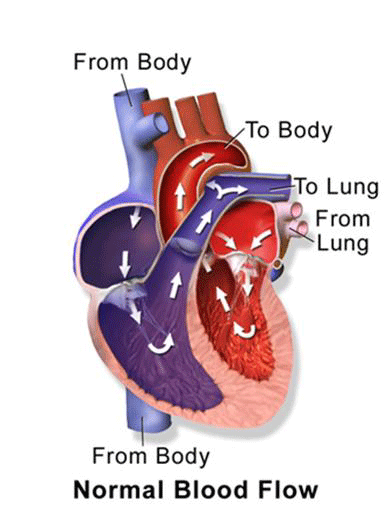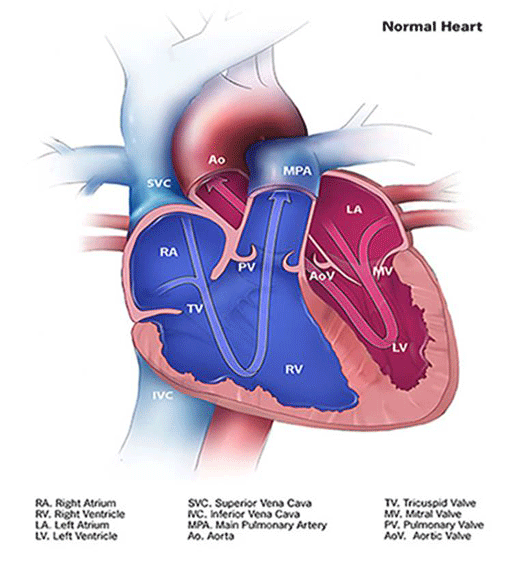Joseph R. Anticaglia MD
Medical Advisory Board
Have you ever run to catch a bus, worked on a strenuous job, played sports or run up a flight of steps? Whether you’re exercising, stressed-out or working hard, the heart needs to adjust to the added physical or emotional stress. It does so, in part, by beating much faster than normal to get more blood circulating around the body. The lungs also adjust by breathing faster than normal to get more oxygen to the heart.
Fortified with oxygen-rich blood and nutrients, the heart pumps blood into the circulation to nourish tissues from the brain to the toes. It supplies the body with the right amount of blood, at the right time, at the right rate to satisfy a person’s metabolic needs.
The heart is a muscular organ, about the size of a fist that contracts rhythmically and beats at a rate that varies from individual to individual from 60 to 100 beats per minute. It is separated by the septum, a partition that divides the heart into the right and left pumping systems.
The right side of the heart receives oxygen-poor blood from the veins of the body which also contain carbon dioxide. The rt. side of the heart pumps blood to the lungs where carbon dioxide is removed from the blood and oxygen is added to the blood.
The left side of the heart gets a fresh supply of oxygen-rich blood from the lungs and pumps it through the arteries to all parts of the body.

The heart has four separate chambers, two on the right side and two on the left side. The upper chambers are the atria. The lower chambers are the ventricles. The ventricles are the main force that propels blood through the lungs and the rest of the body.
Four Chambers of the Heart
Right side
- Right atrium (RA)
- Right ventricle (RV)
Left Side
- Left atrium (LA)
- Left ventricle (LV)
In figures 1 and 2, the right side of the heart in blue is oxygen-poor;
The left side in red is oxygen-rich
The superior vena cava (SVC) and the inferior vena cava (IVA), depicted in light blue in figure 2, are two important veins that return oxygen-poor blood to the right side of the heart.
RV, lower right (dark blue), is the right ventricle; LV, lower left (red), is the left ventricle
Four Valves help regulate the flow of blood in and out of the heart chambers. When the heart muscle squeezes or contracts, the valves open to allow blood to flow out of the chambers. When the heart relaxes, the valves close to prevent the backflow of blood into the chamber. The valves are arranged to keep the blood flowing in one direction. Below are the names of the four heart valves:
Right side:
- Tricuspid valve (TV)
- Pulmonary valve (PV)
Left side:
- Mitral valve (MV)
- Aortic valve (AV)
How Blood Flows In and Out of the Heart
There are several steps concerning the flow of blood in and out of the heart. Oxygen-poor blood goes from the body to the heart to the lungs. Oxygen-rich blood goes from the lungs to the heart to the body. The pumping, muscular action of the heart is a pivotal factor needed for blood to circulate within and outside the heart.
Another important factor regarding how the heart works is the proper functioning of its natural electrical system causing the heart muscle to contract. This system keeps the heart beating at a normal rate and rhythm. For instance, it prevents the heart from beating too rapidly, too slowly or in an irregular pattern (arrhythmia).

1. From the body to the heart
The right atrium-RA, (right upper chamber of the heart), receives oxygen-poor blood from the body’s two main veins, the superior vena cava and the inferior vena cava (light blue).
1A — From the right atrium blood flows through the tricuspid valve (TV) to the right ventricle RV (right the lower chamber of the heart).
2. From the heart to the lungs
The right ventricle pumps the oxygen poor blood through the pulmonary valve (PV) into the main pulmonary artery (MPA) and to the lungs
In the lungs, oxygen is put into the blood and carbon dioxide is taken out of the blood. The oxygenated blood is now referred to as oxygen-rich blood
3. From the lungs to the heart
The oxygen-rich blood from the lungs enters the left atrium (left upper chamber of the heart). It passes through the mitral valve (MV) into the left ventricle (left lower chamber of the heart).
4. From the heart to the body
The left ventricle (LV) pumps the oxygen-rich blood through the aortic valve (AV), into the aorta and out to the rest of the body.
The amount of blood in your body varies tremendously depending on your age, sex and size. The average adult has between nine to twelve pints of blood in his body.
The heart beats about 4,800 times per hour, 115,000 times a day, 42 million times per year and about 3 billion times over s lifetime! The recycling or recirculation of blood due to the pumping action of the heart is a phenomenal achievement.
However, the heart muscle, like other organs in the body, needs oxygen and nutrients to remain healthy. It pumps oxygenated-rich blood to itself through the coronary arteries. Our job is to keep the coronary arteries as healthy as best we can.
References
- Guyton Physiology, Guyton and Hall; Medical Physiology; 13th edition
- BCcampus Open Ed; Anatomy and Physiology, Cardiac Cycle
This article is intended solely as a learning experience. Please consult your physician for diagnostic and treatment options.

